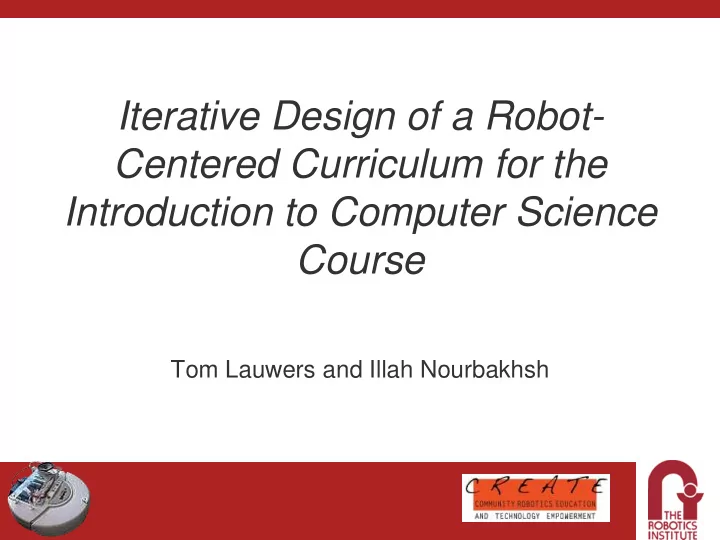

Iterative Design of a Robot- Centered Curriculum for the Introduction to Computer Science Course Tom Lauwers and Illah Nourbakhsh
Focus on Process
Outline • Goals • Robots in CS1 • Our Approach • Results, Design, and more Results!
Design Goals • Motivate students to further study in Computer Science (CS). • Develop standalone modules which can be deployed in introduction to CS (CS1) courses. • Create new robotic technologies that act as an enabler for novel learning interactions. Fig. 1: Newly Declared CS Majors drop from 14,000 to 8,000 in six years. Source, Computer Research News, May 2006.
Robots in CS Education
Our Approach CCAC Ohlone Robot Deep Partnerships Software Curriculum Surveys Pilot Evaluation
Survey Goals • Ground our curricular designs in current classroom realities. • Ensure that enough educators are able and willing to use robots as an educational tool.
Survey Methodology • 33 university and 4 community college CS1 professors participated • Data collected through a phone interview • Responses to open ended questions were coded to examine the frequency of conceptual expression. • Simple statistical methods were used to analyze numerical responses. Fig. 2: Geographic distribution of participants; participants were diverse with respect to size and type of school, gender, and professional level as well.
Survey Results • 12% could make major changes without oversight, 69% could make minor changes • 91% expect students to be able to complete assignments at home • The primary languages in use are Java and C++; only one educator stated that they will change their language • Response to using robots in CS1 was fairly positive, especially amongst professors using Java
Simultaneous Design • Robot • Software Framework/API • Curriculum • Key Design Principle: Alignment
Robot Design • iRobot Create platform • Qwerk controller • TeRK environment • Audio speaker • Webcam (not pictured) • Kitchen sink approach
Software Environment
Curriculum Design • Resources: – Faculty survey – Textbook survey – Prior Partner Curricula and partner input • Decisions: – Modular to allow for ‘drop - in’ activities – Java-based to maximize dissemination potential
Fall 2007 Pilot • Two pilot programs active during fall semester • Ran full curriculum with weekly robotics assignments • CCAC: 72 students, 8 robots. • CCAC students were evaluated for learning, interest, retention
Fall 2007 Results • Bad news: No improvement in retention figures
Retention Rates Students Passing with a C or Better 45.00% 40.00% 35.00% 30.00% 25.00% 20.00% 15.00% 10.00% 5.00% 0.00% 2003 2004 2005 2006 2007 Year
Fall 2007 Results • Good news: Increased student interest among completing students
Student Interest Favorite assignments 90.00% 80.00% favorite same as 70.00% current 60.00% fun also 50.00% 40.00% simple better 30.00% 20.00% challenge better 10.00% 0.00% Assign3 Assign4 Assign5 Assign6 Assign7 Assign8 Assign9 Assign11 Assignment
Student Interest Completing Students who Finished All Assigned Work 90.00% 80.00% 70.00% 60.00% 50.00% 40.00% 30.00% 20.00% 10.00% 0.00% 2003 2004 2005 2006 2007
Next Steps • Use Evaluation Results to Redesign – Optimal Feature Set – Motivating Characteristics of Activities • Pilot again in Fall 2008 – Stronger Control Group – Looking for additional partners • Involvement of High School Teachers – July workshop
Questions, Comments? Create Robot Building recipe: http://www.terk.ri.cmu.edu/recipes/create-overview.php Latest Java software for CS1 students: http://www.terk.ri.cmu.edu/software/myfirstrobot-overview.php Curriculum Overview: http://www.terk.ri.cmu.edu/curricula/introCS-overview.php This material is based partially upon work supported by the National Science Foundation under Grant No. 0632887 We’d like to thank , , and the Arthur Vining Davis Foundations for their support.
Recommend
More recommend